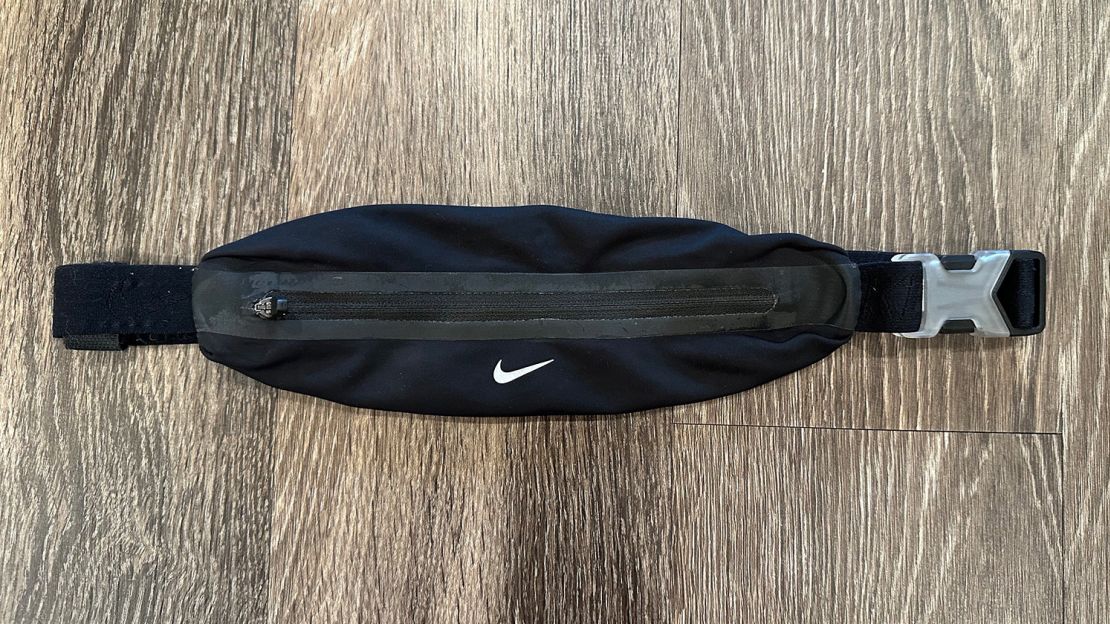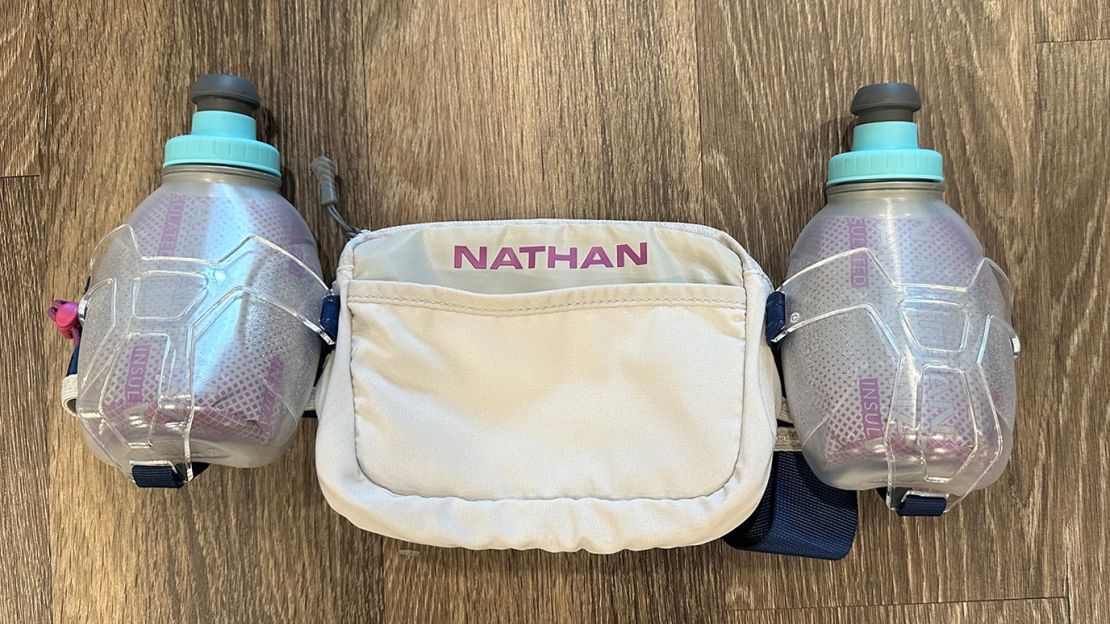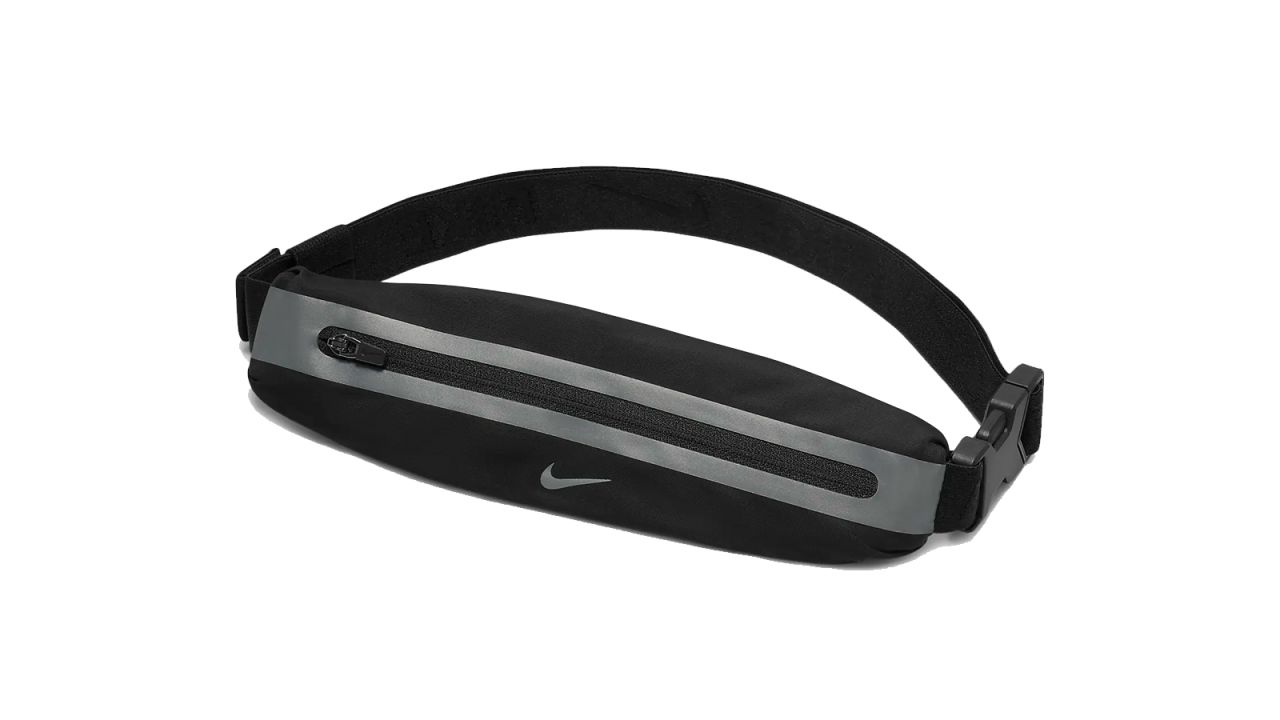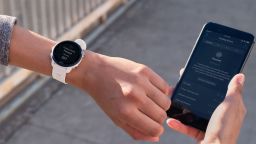The best running belts we tested:
Best running belt for short runs: Nike Slim Running Fanny Pack
Best storage running belt: Camelbak Ultra Belt
Best running belt for hydration: Nathan Sports TrailMix Plus Insulated Hydration Belt 3.0
Best running belt for long runs: Ultimate Direction Comfort Belt
As health and fitness addicts know, you don’t need much when you head out for a run, but you do need a way to carry the essentials. Whether you’re carrying your phone, keys, credit cards or all of the above, usually running shorts don’t cut it. That’s where running belts come in.
To find the best running belts, we brought in 11 different options, from the most streamlined straps to wider waistbands offering multiple storage options. We spent hours pounding the pavement to determine which ones felt best during runs, whether we were running short or long or had extra requirements like water or fuel or to ditch that layer we definitely didn’t need once the sun came up. In the process, we found four great belts to serve different runners’ needs.
This low-cost, no-frills running belt does everything it needs to do. Not only can it safely store everything from keys to a phone to credit cards, but it’s also super comfortable, lightweight and fast-drying in case you get stuck in the rain.
When you need to carry lots, especially on longer runs, the Camelbak Ultra Belt will hold it all. The wide waist belt can fit water, fuel and even extra layers. And it comes with a zippered pocket for a phone, cash and cards. Just be sure to measure your waist because this belt comes in three different sizes.
An updated holster design allows you to easily access two 10-ounce hard flasks using just one hand. Of course, it’s still got an expandable pocket for other stuff, like your phone, and though it's heavier than the other options, its lightweight material won’t weigh you down when you run.
With four pockets lining the inside of the Ultimate Direction Comfort Belt, it helps streamline your storage. And with no zip pocket, there’s minimal bounce when you run longer distances. This belt comes in five sizes, so you’ll want to make sure you measure correctly before you buy, though it does run true to size.
Best running belt for short runs: Nike Slim Running Fanny Pack
$20 at Dick’s Sporting Goods; $25 From $22 at Nike; or $25 at Amazon

When you’re not running long, you don’t need anything fancy — just a belt that can hold your phone, your keys, and maybe a card or cash. This budget-friendly belt fits the bill.
We’ve run at least two marathons and countless training runs in the Nike Slim Running Fanny Pack, and we love how comfortable the stretchy elastic waistband is. With its adjustable buckle, it can be worn at the hips or the waist. For what it’s worth, we prefer it around the hips, but other runners may like to wear it a little higher. Either way works great!
This one-size-fits-most belt is made from polyester with a touch of spandex for stretch. Since polyester is lightweight, breathable and fast-drying, there’s no extra heat added to your waist or lower back — even with an iPhone Pro 14 Max in there. And the expandable pocket, which zips closed for security, is large enough to fit most smartphones. We don’t recommend overstuffing the pocket, though. While a phone lays flat against your back in the pouch, we found that after adding gel packets (a necessity for longer runs), we had to deal with more movement around our waist throughout our run.
But even with a bigger phone, there’s minimal bounce; the zipper is surrounded by reflective material that’s in line with the elastic of the belt, which prevents the zipper from rotating upwards as you run. (This can occur in belts with less structure, and causes the phone to bounce against your lower back unless you shift the pocket around — no thanks).
Best storage running belt: Camelbak Ultra Belt
From $49 at Amazon or $60 at Camelbak

On longer runs, you can’t get away with just carrying your phone, keys and money. You definitely need fuel, you might need to carry water and you’ll likely want to shed layers as you heat up. This wide waistband can handle all that and then some.
We wore the Camelbak Ultra Belt in the Chicago Marathon in 2021, an incredibly hot race year. This pull-on belt, made from a 3D Micro Mesh that encourages multidirectional airflow, shockingly didn’t make us any hotter than we already were — and that stayed true as we put it to the test again on long runs in Denver’s summer heat.
With four pockets, there’s no shortage of storage space. One pocket is specifically designed for a 17-ounce Quick Stow soft flask, and there’s a phone pocket with a zipper closure (we had to take the case off of our iPhone in order to make getting it in and out as easy as possible), as well as two pockets with flap closures. For long runs, we were able to carry seven gels in this belt no problem. There are even loops for trekking poles on the back, but since we weren’t tackling any gnarly terrain, we used these for holding a shirt and rain jacket instead.
The Ultra Belt comes in three sizes (XS/S, S/M, M/L), so make sure to measure your waist properly to get the right fit. While it’s designed to hug the body, the wrong size can lead to a lot of tugging throughout your run if the belt rides up or down.
Best running belt for hydration: Nathan Sports TrailMix Plus Insulated Hydration Belt 3.0
$65 at Nathan Sports

A good rule of thumb when running is to take in 4 to 6 ounces of fluid every 20 minutes. But to do that, you can’t rely on public water fountains or Starbucks employees; you need to carry it with you.
The Nathan Sports TrailMix Plus Insulated Hydration Belt 3.0 uses an updated holster design that allows you easy, one-handed access to two 10-ounce hard flasks. The holsters themselves are made from a flexible plastic, so we didn’t experience uncomfortable digging into our back as we ran.
In between the two bottle holders is a large, expandable zipper pocket that fits most large smartphones, including the iPhone 14 Pro Max, as well as multiple gels and any other small essentials (e.g., your keys and credit card/cash). There’s also an exterior mesh pocket where you can store anything you need easy access to, and two shock cords with one-pull tension locks at the sides for extra carrying capacity.
While this is definitely heavier than more low-profile options, we found the nylon/polyester blend to be breathable and fast-drying, so it’s not like this is going to weigh you down. The adjustable buckle makes this one-size-fits-most, especially considering how much excess fabric Nathan provided on the strap — don’t worry, it can be folded down and tucked into a strap so it’s not flapping around as you run.
Best running belt for long runs: Ultimate Direction Comfort Belt
$30 at Ultimate Direction or $35 at Moosejaw

The Ultimate Direction Comfort Belt felt like a more streamlined version of the Camelbak Ultra Belt, which made it ideal for long runs or speedier workouts.
We really liked how flush this felt next to our body, even when we loaded up the four pockets for a 20-mile marathon training run. The pockets all sit on the inside lining of the belt, closer to the body, while the outside material is a little taller; that reduces the likelihood of anything bouncing out (especially since there’s no zip pocket). The two larger pockets comfortably fit our phone and a 17-ounce soft flask, and one of those had a built-in key clip for added security. Silicone-printed elastic straps can hold trekking poles, and loops at the bottom wrap around any layers you need to shed.
Another pull-on option, the Comfort Belt comes in five sizes — from XS to XL — for an accurate fit. Made from a polyester/spandex blend (that’s lightweight, breathable and fast-drying), we found it to run true to size, although it will feel a little tight when it’s totally packed. That snug fit is a good thing; we didn’t experience any bouncing, even with a full water bottle tucked into the pocket at the start or our long run.
Depending on the fit, it may require some adjusting throughout your run, but we found ourselves tugging at it significantly less than some of the other pull-on belts we tested.
What to consider when shopping for running belts
Comfort
The right fit is crucial when it comes to a running belt, because you don’t want it to distract you from your run. Some belts fit best at the waist and some sit better on the hips; either way, it should be snug to your body without digging in uncomfortably or riding up with every stride. Pay attention to how a belt feels once you stuff your essentials in the storage compartments or add water. Some pouches may bounce if you put more than a phone and your keys in them, and a belt may feel different when you fill up its water bottles and start to move. Adding weight around your waist or hips can also add heat, so look for materials with breathable, sweat-wicking and fast-drying properties.
Storage
The whole point of wearing a running belt is to carry what you might need on your run. That’s going to vary runner to runner. If you just need something to stash your phone, house keys and maybe a credit card, a simple, single-pocket belt will be fine (just make sure to choose one that’s designed to accommodate your phone, especially if you have a larger one). Other belts have multiple pockets, elastic loops for holding gel packets, external shock cord systems that can hold a long-sleeve top or jacket if you overheat, straps for trekking poles and pockets or holders designed especially for water bottles. Accessibility can be important, so you should consider whether you prefer pockets with zippers, slits or flaps; some belts are also designed so the pockets are on the interior, which is great for security but will make it more difficult to access them.
Enclosure
Many belts are of the one-size-fits-all variety, with an adjustable buckle that allows you to dial in the perfect fit (and adjust on the fly). The size of the buckle and strap may play a role in comfort; the larger and sturdier they are, the more likely the belt will move up or down as you’re running. Another type is called a tube belt — this is the kind of belt you step into and pull up around your waist or hips. These come in different sizes that correspond to your body measurements, so make sure to follow a brand’s sizing instructions before purchasing.
How we tested
We picked 11 of the most popular running belts, including ones we’ve trained and raced with in the past, ones recommended to us by fellow runners and ones that were well reviewed online. Then, to compare their performance and effectiveness, we logged over an hour in each belt, stuffing the pockets with our phone (an iPhone 14 Pro Max), a credit card, our house keys and four gel packets for fuel, and filling up the water flasks or bottles when that was an option. Over the course of our runs, we assessed all of the belts for cost and the following criteria:
Design
- Storage: Extra storage is the entire reason runners wear belts, so we paid special attention to capacity and accessibility.
- Breathability: How well did each running belt wick sweat? We continually asked ourselves that question during our runs, assessing the belts for their ability to regulate moisture.
Fit
- Comfort: Comfort was a key criterion that we used to determine our winners. Whether a running belt sits on your hips or your waist, the best ones feel as if they aren’t there.
- Adjustability: It doesn’t matter how breathable a running belt is if you can’t adjust it to your liking. We tried to adjust each belt whenever possible to test fit and comfortability.
Other running belts we tested
SPIbelt Large Pocket
$27 at SPIbelt
SPIbelt is a hugely popular brand among runners, and we actually wore this belt for our first four marathons. The design — a stretchy elastic belt with an expandable pocket made from a sweat-wicking synthetic material — is super similar to the Nike Slim Running Fanny Pack, but we did find this one to bounce more with larger phones and more gels. It’s still a great option for shorter runs, and it can fit waist sizes above 47 inches with a belt expander (purchased separately).
SPIbelt Performance Series
$30 at SPIbelt
The Performance Series belt from SPIbelt is essentially the same as the one above, except this one has four elastic loops to place gels so that they’re easily accessible on longer runs. Personally, we’re always afraid of losing gels with loops like these, but there were no casualties during testing. You can also use the loops for clip-on keys, pepper spray, etc., and this version has a weather-resistant zipper and pocket to protect your phone from the elements.
Nathan Adjustable-Fit Zipster 2.0
$35 at Nathan Sports
Nathan’s Adjustable-Fit Zipster 2.0 falls into the same simplistic category as the SPIbelts or Nike Fanny Pack. It has three individual pockets, including a zippered weather-resistant pocket, as well as an adjustable buckle, and is made from a stretchy, moisture-wicking blend of nylon and spandex that contours to your waist. We found that the wider waistband moved a lot on our body as we ran, maybe due to the smoother fabric or the larger buckle.
Nathan Peak Hydration Waist Pak
$40 at Nathan Sports
We really liked the design of Nathan’s Peak Hydration Waist Pak, which has an angled, 18-ounce hard bottle holder that allows for easy, one-handed access and extended side panels for a better fit — but we didn’t love how much it bounced and moved around during runs (it felt great, though, during a hike!). The zip pockets weren’t quite big enough for a large smartphone and a bunch of gels, but we appreciated the option of a shock cord on the side for holding extra layers or clipping on your keys.
Lululemon Fast and Free Running Belt
$38 at Lululemon
This could be an alternative for the SPIbelt or Nike belts. It’s also made from Lululemon’s Nulux fabric, a lightweight, sweat-wicking, quick-drying material with added Lycra fiber for stretch and shape retention. Less stretch in the adjustable band was slightly more uncomfortable (we wouldn’t wear it without a shirt), but the addition of two small drop-in pockets for keys, cards and gels next to the zippered phone pouch make this a worthy option for shorter runs.
Ultimate Direction Utility Belt
$40 at Ultimate Direction
We found the Ultimate Direction Utility Belt to be a slightly heavier-duty version of the brand’s Comfort Belt. They both have four pockets and can carry poles, can fit a 17-ounce soft flask and are made from lightweight, breathable polyester. We found this one to be slightly more compressive, which some runners may prefer; we had a gel and our water bottle each pop out at one point, so make sure to get the right size.
Proviz Reflect360 Enhanced Visibility Running Belt
$45 $23 at Proviz
The Proviz Reflect360 Enhanced Visibility Running Belt stood out from the rest in that it’s a Velcro belt — you just wrap it around your waist to find the perfect fit (it accommodates sizes up to 46 inches). You will have to undo the belt to get to the three interior pockets, but that wasn’t a deal breaker for us. This is a great option if you tend to run in low-light conditions; the moisture-wicking, quick-drying and breathable material has reflective print on all sides.























